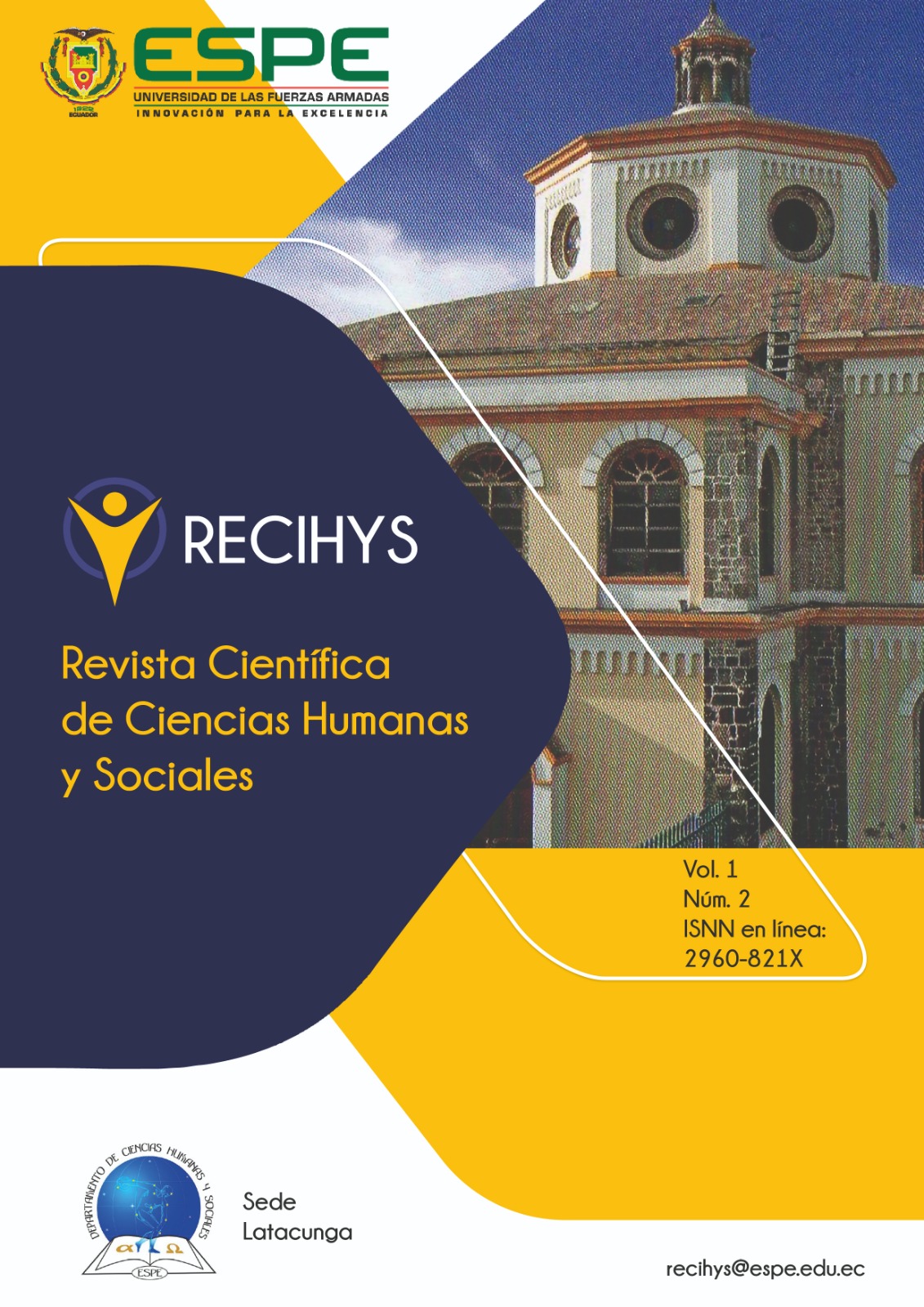Implementación de las actividades recreativas al aire libre para el aprovechamiento de los recursos naturales turísticos de la parroquia de Lloa-Ecuador
Contenido principal del artículo
Resumen
La recreación se conoce, como una actividad destinada a un aprovechamiento del tiempo libre, hoy en día es un factor esencial para el ámbito turístico, ya que de tal manera la recreación se relaciona con el turismo y tiene un rol importante en la calidad de vida de la sociedad, de tal manera que la satisfacción de los turistas depende de las diferentes actividades recreativas para un esparcimiento que se realiza durante la visita. Esta investigación se realizó con el propósito de determinar la importancia de la implementación de las actividades recreativas para el fortalecimiento de los recursos naturales turísticos de la parroquia Lloa. La metodología fue de enfoque cualitativo, de revisión bibliográfico y documental, a través de fuentes esenciales como libros, artículos, entre otros que tienen como base la implementación de actividades recreativas que se puede ejecutar en el análisis del contenido. Los resultados obtenidos se desarrollaron en base a la revisión de varios autores. Finalmente se puntualiza que llevar a cabo la ejecución de actividades recreativas puede ser una aportación significativa para mejorar el aprovechamiento de los recursos naturales que posee.
##plugins.themes.bootstrap3.displayStats.downloads##
Detalles del artículo

Esta obra está bajo una licencia internacional Creative Commons Atribución-NoComercial-SinDerivadas 4.0.
Los autores que publican en esta revista están de acuerdo con los siguientes términos: Los autores conservan los derechos de autor y garantizan a la revista el derecho de ser la primera publicación del trabajo al igual que licenciado bajo una Creative Commons Attribution License CC BY-NC-ND 4.0 que permite a otros compartir el trabajo con un reconocimiento de la autoría del trabajo y la publicación inicial en esta revista. Los autores pueden establecer por separado acuerdos adicionales para la distribución no exclusiva de la versión de la obra publicada en la revista (por ejemplo, situarlo en un repositorio institucional o publicarlo en un libro), con un reconocimiento de su publicación inicial en esta revista. Se permite y se anima a los autores a difundir sus trabajos electrónicamente (por ejemplo, en repositorios institucionales o en su propio sitio web) antes y durante el proceso de envío, ya que puede dar lugar a intercambios productivos, así como a una citación más temprana y mayor de los trabajos publicados.
Cómo citar
Referencias
Albán, G. P. G., Arguello, A. E. V., & Molina, N. E. C. (2020). Metodologías de investigación educativa (descriptivas, experimentales, participativas, y de investigación-acción). Recimundo, 4(3), 163-173.
Bernal, C. (2010). Metodología de la investigación (Tercera edición).
Bertoni, M. (2005). Recursos naturales en nodos turísticos. Aportes y Transferencias, 9(2), 95-111.
Cabezas, E. D., Andrade, D., & Torres, J. (2018). Introducción a la Metodología de la Investigación Científica. http://repositorio.espe.edu.ec/xmlui/bitstream/handle/21000/15424/Introduccion%20a%20la%20Metodologia%20de%20la%20investigacion%20cientifica.pdf?sequence=1&isAllowed=y
Camara, C. J., & Morcate, F. de los Á. (2014). Metodología para la identificación, clasificación y evaluación de los recursos territoriales turísticos del centro de ciudad de Fort-de-France. XXXV(1), 48-67.
Cañar Merelo, L. A. (2019). Diseño de un área de recreación turística en la cascada “El Imán”, provincia de los Ríos, año 2019. [Universidad Técnica Estatal de Quevedo]. https://repositorio.uteq.edu.ec/bitstream/43000/3923/1/T-UTEQ-0047.pdf
Carvajal, G. V., & Lemoine, F. A. (2018). Análisis de los atractivos y recursos turísticos del cantón San Vicente. 34, 164-184.
Castañer, M., & Camerino, O. C. (2001). La educación física en la enseñanza primaria: Una propuesta currículo para la reforma. INDE. https://books.google.com.br/books?id=qfKvHKCQzPQC&printsec=frontcover&hl=es#v=onepage&q&f=false
Collay, J. (2020). Actividades turístico recreativas para la dinamización del flujo de visitantes en las Pampas de Salasaca [Universidad Técnica de Ambato]. https://repositorio.uta.edu.ec/bitstream/123456789/31661/1/COLLAY%20SALAZAR%20DAYANA%20-ACTIVIDADES%20TURISTICO%20RECREATIVAS%20PARA%20LA%20DINAMIZACION%20DEL%20FLUJO%20DE%20VISITANTES%20EN%20LAS%20PAMPAS%20DE%20SALASACA_.pdf
Constitución de la República del Ecuador. (2008). https://www.acnur.org/fileadmin/Documentos/BDL/2008/6716.pdf
García, P. A., & Feria, M. F. (2022). Propuesta de actividades recreativas para el fortalecimiento del desarrollo turístico en el atractivo cerro y mirador El Calvario, cantón Zaruma. [Universidad Técnica de Machala]. http://repositorio.utmachala.edu.ec/bitstream/48000/19243/1/Trabajo_Titulacion_657.pdf
Gomes, C. J. G., & Turato, E. R. (2009). Análisis de contenido en investigaciones que utilizan la metodología clínico-cualitativa: Aplicación y perspectivas. Revista Latino-Americana de Enfermagem, 17(2), 259-264. https://doi.org/10.1590/S0104-11692009000200019
Gutiérrez, R., & Sánchez, J. (1990). Metodología del trabajo intelectual.10a ed. México: Esfinge. https://books.google.com.bo/books/about/Metodolog%C3%ADa_del_trabajo_intelectual.html?id=GK0QAAAAYAAJ&utm_source=gb-gplus-shareMetodolog
Grimaldi Puyana, M., Sánchez-Oliver, A. J., Alcaraz Rodríguez, V., & Pérez Villalba, M. (2017). Satisfacción laboral de trabajadores de actividades deportivas y recreativas en turismo activo. https://idus.us.es/handle/11441/85997
Larson, S., Farr, M., Stoeckl, N., Chacon, A., & Esparon, M. (2014). Does Participation in Outdoor Activities Determine Residents’ Appreciation of Nature: A Case Study From the Great Barrier Reef, Australia. Environment and Natural Resources Research, 4, 211-226. https://doi.org/10.5539/enrr.v4n3p212
Lozada, M. (2019). Recurso natural y los emprendimientos turísticos en el balneario de Agua Dulce la Reveza del cantón Palenque de la provincia de los Ríos [Universidad Técnica de Babahoyo]. http://dspace.utb.edu.ec/bitstream/handle/49000/6215/P-UTB-FCJSE-HTURIS-000075.pdf?sequence=1&isAllowed=y
Maya, E. (2014). Métodos y técnicas de investigación. Universidad Nacional Autónoma de México. http://www.librosoa.unam.mx/handle/123456789/2418
Merlotto, A., & Verón, E. M. (2019). Evaluación de los servicios culturales de recreación y turismo del ecosistema playa en la ciudad de Mar del Plata, Argentina. Revista Universitaria de Geografía, 28(2), 35-56.
Nasimba, C. y Cejas, M. (2015). Diseño de productos turísticos y sus facilidades. Ecuador. Revista Qualitas. Volumen 10. 22-39. https://www.researchgate.net/profile/Nasimba-Maribel/publication/333221285_Articulo_de_revision_DISENO_DE_PRODUCTOS_TURISTICOS_Y_SUS_FACILIDADES/links/5ce2cde7299bf14d95aa8667/Articulo-de-revision-DISENO-DE-PRODUCTOS-TURISTICOS-Y-SUS-FACILIDADES.pdf
Pérez Porto J, P. P., J. ,. Merino, M. (2015). Definición de actividades recreativas—Definicion.de. Definición de actividades recreativas - Qué es, Significado y Concepto. Definicion.de. https://definicion.de/actividades-recreativas/
Sánchez Flores, F. A. (2019). Fundamentos Epistémicos de la Investigación Cualitativa y Cuantitativa: Consensos y Disensos. Revista Digital de Investigación en Docencia Universitaria, 101-122. https://doi.org/10.19083/ridu.2019.644
Secretaría Nacional de Planificación. (2021). Plan de Creación de Oportunidades 2021-2025. https://observatorioplanificacion.cepal.org/sites/default/files/plan/files/Plan-de-Creaci%C3%B3n-de-Oportunidades-2021-2025-Aprobado_compressed.pdf
Sjögren, K., Hansson, E. E., & Stjernberg, L. (2011). Parenthood and factors that influence outdoor recreational physical activity from a gender perspective. BMC Public Health, 11(1), 93. https://doi.org/10.1186/1471-2458-11-93

